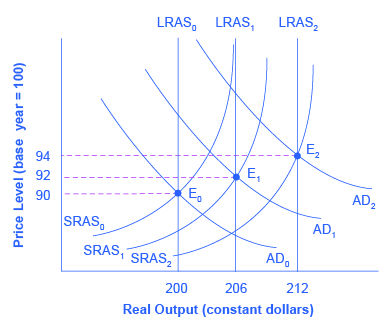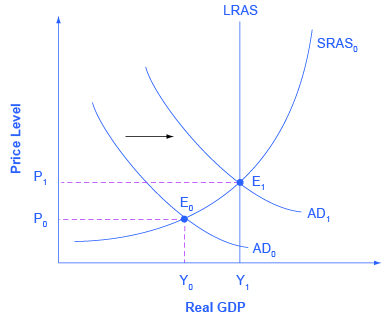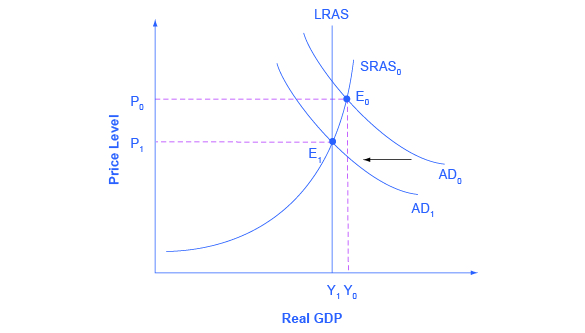What Changes Should They Make If They Decide A Contractionary Fiscal Policy Isã¢â‚¬â€¹ Necessary?
Government Budgets and Financial Policy
Using Financial Policy to Fight Recession, Unemployment, and Aggrandizement
Learning Objectives
By the end of this section, you will be able to:
- Explain how expansionary financial policy can shift aggregate demand and influence the economy
- Explicate how contractionary fiscal policy can shift aggregate need and influence the economy
Financial policy is the use of government spending and revenue enhancement policy to influence the path of the economy over time. Graphically, we see that fiscal policy, whether through changes in spending or taxes, shifts the aggregate need outward in the case of expansionary fiscal policy and inward in the case of contractionary fiscal policy. We know from the chapter on economic growth that over time the quantity and quality of our resources abound as the population and thus the labor forcefulness become larger, as businesses invest in new uppercase, and as engineering improves. The result of this is regular shifts to the right of the aggregate supply curves, equally (Figure) illustrates.
The original equilibrium occurs at E0, the intersection of aggregate demand bend AD0 and aggregate supply curve SRAS0, at an output level of 200 and a price level of 90. 1 twelvemonth afterwards, aggregate supply has shifted to the right to SRAS1 in the process of long-term economical growth, and aggregate demand has besides shifted to the correct to AD1, keeping the economy operating at the new level of potential GDP. The new equilibrium (Eane) is an output level of 206 and a price level of 92. One more twelvemonth later, amass supply has once more shifted to the right, at present to SRAS2, and amass demand shifts correct besides to AD2. At present the equilibrium is Etwo, with an output level of 212 and a toll level of 94. In brusque, the figure shows an economy that is growing steadily yr to yr, producing at its potential GDP each yr, with merely small-scale inflationary increases in the price level.
A Salubrious, Growing Economy
In this well-functioning economic system, each year amass supply and amass demand shift to the correct so that the economic system proceeds from equilibrium E0 to E1 to Etwo. Each year, the economic system produces at potential Gross domestic product with only a pocket-size inflationary increment in the price level. However, if aggregate demand does non smoothly shift to the correct and match increases in aggregate supply, growth with deflation tin can develop.

Aggregate demand and aggregate supply do not always move neatly together. Call up about what causes shifts in amass demand over time. As aggregate supply increases, incomes tend to go up. This tends to increment consumer and investment spending, shifting the aggregate need curve to the correct, but in whatsoever given period information technology may not shift the aforementioned corporeality as amass supply. What happens to authorities spending and taxes? Government spends to pay for the ordinary business organization of government- items such as national defence, social security, and healthcare, every bit (Effigy) shows. Tax revenues, in office, pay for these expenditures. The result may be an increase in aggregate demand more than or less than the increment in aggregate supply.
Amass need may fail to increase along with amass supply, or amass need may even shift left, for a number of possible reasons: households get hesitant almost consuming; firms decide against investing as much; or mayhap the demand from other countries for exports diminishes.
For example, investment past private firms in physical majuscule in the U.S. economy boomed during the late 1990s, rising from 14.1% of Gdp in 1993 to 17.2% in 2000, before falling dorsum to 15.2% by 2002. Conversely, if shifts in amass need run alee of increases in aggregate supply, inflationary increases in the price level will result. Business cycles of recession and recovery are the consequence of shifts in aggregate supply and aggregate demand. As these occur, the regime may choose to use fiscal policy to address the difference.
Monetary Policy and Depository financial institution Regulation shows the states that a fundamental bank can utilize its powers over the banking arrangement to engage in countercyclical—or "confronting the business cycle"—actions. If recession threatens, the central bank uses an expansionary monetary policy to increment the money supply, increment the quantity of loans, reduce interest rates, and shift aggregate demand to the right. If inflation threatens, the central bank uses contractionary monetary policy to reduce the money supply, reduce the quantity of loans, raise interest rates, and shift amass demand to the left. Fiscal policy is another macroeconomic policy tool for adjusting aggregate demand by using either government spending or tax policy.
Expansionary Financial Policy
Expansionary financial policy increases the level of amass need, through either increases in authorities spending or reductions in tax rates. Expansionary policy tin can do this by (i) increasing consumption past raising disposable income through cuts in personal income taxes or payroll taxes; (2) increasing investment spending by raising afterwards-tax profits through cuts in business organisation taxes; and (three) increasing regime purchases through increased federal regime spending on final goods and services and raising federal grants to country and local governments to increase their expenditures on last goods and services. Contractionary financial policy does the reverse: it decreases the level of aggregate need by decreasing consumption, decreasing investment, and decreasing government spending, either through cuts in government spending or increases in taxes. The aggregate demand/aggregate supply model is useful in judging whether expansionary or contractionary fiscal policy is appropriate.
Consider offset the situation in (Effigy), which is similar to the U.South. economy during the 2008-2009 recession. The intersection of aggregate demand (AD0) and amass supply (SRAS0) is occurring beneath the level of potential GDP as the LRAS bend indicates. At the equilibrium (E0), a recession occurs and unemployment rises. In this case, expansionary fiscal policy using revenue enhancement cuts or increases in government spending can shift aggregate demand to Advertisementone, closer to the full-employment level of output. In addition, the price level would rise back to the level P1 associated with potential Gdp.
Expansionary Financial Policy
The original equilibrium (Due east0) represents a recession, occurring at a quantity of output (Y0) below potential GDP. Still, a shift of aggregate need from Advertizing0 to Advertizement1, enacted through an expansionary financial policy, can move the economy to a new equilibrium output of Eane at the level of potential GDP which the LRAS curve shows. Since the economy was originally producing beneath potential GDP, any inflationary increase in the price level from P0 to P1 that results should be relatively small.

Should the regime use taxation cuts or spending increases, or a mix of the ii, to conduct out expansionary financial policy? During the 2008-2009 Nifty Recession (which started, actually, in late 2007), the U.S. economic system suffered a 3.1% cumulative loss of Gross domestic product. That may not sound like much, but information technology's more than i year'due south average growth rate of Gross domestic product. Over that fourth dimension frame, the unemployment rate doubled from five% to 10%. The consensus view is that this was mayhap the worst economic downturn in U.S. history since the 1930's Great Depression. The choice betwixt whether to employ tax or spending tools often has a political tinge. As a general statement, conservatives and Republicans prefer to see expansionary fiscal policy carried out by tax cuts, while liberals and Democrats prefer that the government implement expansionary fiscal policy through spending increases. In a bipartisan attempt to address the farthermost state of affairs, the Obama administration and Congress passed an $830 billion expansionary policy in early 2009 involving both tax cuts and increases in government spending. At the same time, nonetheless, the federal stimulus was partially offset when state and local governments, whose budgets were hard striking by the recession, began cut their spending.
The disharmonize over which policy tool to use can be frustrating to those who want to categorize economics every bit "liberal" or "conservative," or who want to utilise economic models to argue against their political opponents. Notwithstanding, advocates of smaller regime, who seek to reduce taxes and government spending tin use the AD Equally model, also as advocates of bigger government, who seek to raise taxes and authorities spending. Economic studies of specific taxing and spending programs can help inform decisions about whether the authorities should change taxes or spending, and in what ways. Ultimately, decisions virtually whether to use tax or spending mechanisms to implement macroeconomic policy is a political decision rather than a purely economic one.
Contractionary Fiscal Policy
Fiscal policy tin also contribute to pushing aggregate need beyond potential GDP in a style that leads to inflation. Equally (Figure) shows, a very large upkeep deficit pushes up aggregate demand, and so that the intersection of aggregate demand (AD0) and aggregate supply (SRAS0) occurs at equilibrium E0, which is an output level higher up potential Gdp. Economists sometimes telephone call this an "overheating economic system" where demand is so high that in that location is upwardly pressure on wages and prices, causing inflation. In this state of affairs, contractionary fiscal policy involving federal spending cuts or revenue enhancement increases can assist to reduce the upward pressure on the price level past shifting aggregate demand to the left, to AD1, and causing the new equilibrium Eastward1 to be at potential GDP, where aggregate need intersects the LRAS curve.
A Contractionary Fiscal Policy
The economy starts at the equilibrium quantity of output Y0, which is above potential GDP. The extremely loftier level of amass demand will generate inflationary increases in the price level. A contractionary fiscal policy can shift aggregate demand down from AD0 to ADone, leading to a new equilibrium output Due east1, which occurs at potential GDP, where AD1 intersects the LRAS curve.

Over again, the AD–Equally model does non dictate how the authorities should carry out this contractionary fiscal policy. Some may adopt spending cuts; others may prefer tax increases; however others may say that it depends on the specific situation. The model merely argues that, in this situation, the government needs to reduce aggregate need.
Primal Concepts and Summary
Expansionary fiscal policy increases the level of aggregate demand, either through increases in government spending or through reductions in taxes. Expansionary fiscal policy is most advisable when an economy is in recession and producing below its potential Gdp. Contractionary fiscal policy decreases the level of amass demand, either through cuts in regime spending or increases in taxes. Contractionary fiscal policy is most advisable when an economy is producing above its potential Gross domestic product.
Self-Check Questions
What is the master reason for employing contractionary fiscal policy in a time of stiff economic growth?
To keep prices from ascension too much or too rapidly.
What is the chief reason for employing expansionary fiscal policy during a recession?
To increase employment.
Review Questions
What is the difference between expansionary fiscal policy and contractionary fiscal policy?
Under what general macroeconomic circumstances might a regime utilize expansionary financial policy? When might it apply contractionary financial policy?
Critical Thinking Questions
How will cuts in state budget spending impact federal expansionary policy?
Is expansionary fiscal policy more than attractive to politicians who believe in larger government or to politicians who believe in smaller government? Explain your answer.
Problems
Specify whether expansionary or contractionary fiscal policy would seem to be most appropriate in response to each of the situations beneath and sketch a diagram using aggregate demand and aggregate supply curves to illustrate your answer:
- A recession.
- A stock market collapse that hurts consumer and business confidence.
- Extremely rapid growth of exports.
- Rising aggrandizement.
- A ascent in the natural rate of unemployment.
- A rise in oil prices.
References
Alesina, Alberto, and Francesco Giavazzi. Fiscal Policy afterwards the Financial Crisis (National Bureau of Economic Enquiry Conference Written report). Chicago: University Of Chicago Printing, 2013.
Martin, Fernando M. "Financial Policy in the Cracking Recession and Lessons from the Past." Federal Reserve Depository financial institution of St. Louis: Economic Synopses. no. i (2012). http://research.stlouisfed.org/publications/es/12/ES_2012-01-06.pdf.
Bivens, Josh, Andrew Fieldhouse, and Heidi Shierholz. "From Free-fall to Stagnation: Five Years Afterwards the Get-go of the Great Recession, Extraordinary Policy Measures Are Still Needed, But Are Non Forthcoming." Economic Policy Establish. Concluding modified February 14, 2013. http://www.epi.org/publication/bp355-five-years-after-start-of-cracking-recession/.
Lucking, Brian, and Dan Wilson. Federal Reserve Depository financial institution of San Francisco, "FRBSF Economical Letter—U.Southward. Fiscal Policy: Headwind or Tailwind?" Final modified July two, 2012. http://www.frbsf.org/economic-enquiry/publications/economic-letter/2012/july/united states of america-fiscal-policy/.
Greenstone, Michael, and Adam Looney. Brookings. "The Office of Fiscal Stimulus in the Ongoing Recovery." Concluding modified July 6, 2012. http://world wide web.brookings.edu/blogs/jobs/posts/2012/07/06-jobs-greenstone-looney.
Glossary
- contractionary fiscal policy
- fiscal policy that decreases the level of amass demand, either through cuts in regime spending or increases in taxes
- expansionary fiscal policy
- fiscal policy that increases the level of aggregate need, either through increases in government spending or cuts in taxes
Source: https://opentextbc.ca/principlesofeconomics2eopenstax/chapter/using-fiscal-policy-to-fight-recession-unemployment-and-inflation/
Posted by: warrenexhaf1942.blogspot.com

0 Response to "What Changes Should They Make If They Decide A Contractionary Fiscal Policy Isã¢â‚¬â€¹ Necessary?"
Post a Comment